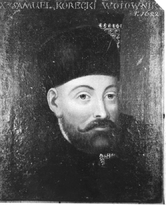
Samuel Korecki
Encyclopedia

Polish-Lithuanian Commonwealth
The Polish–Lithuanian Commonwealth was a dualistic state of Poland and Lithuania ruled by a common monarch. It was the largest and one of the most populous countries of 16th- and 17th‑century Europe with some and a multi-ethnic population of 11 million at its peak in the early 17th century...
. His coat of arms
Coat of arms
A coat of arms is a unique heraldic design on a shield or escutcheon or on a surcoat or tabard used to cover and protect armour and to identify the wearer. Thus the term is often stated as "coat-armour", because it was anciently displayed on the front of a coat of cloth...
was Pogonia
Pogonia coat of arms
Pogonia - is a Polish Coat of Arms. It was used by several szlachta families in the times of the Polish-Lithuanian Commonwealth.The knights used to get distinctive badges in fights with enemies....
. In his military career he achieved the rank of colonel. He fought under hetman
Hetman
Hetman was the title of the second-highest military commander in 15th- to 18th-century Poland and the Grand Duchy of Lithuania, which together, from 1569 to 1795, comprised the Polish-Lithuanian Commonwealth, or Rzeczpospolita....
Stanisław Żółkiewski at Guzow
Battle of Guzów
The Battle of Guzów took place on July 6, 1607, at the village of Guzów in Szydłowiec County, Polish-Lithuanian Commonwealth. The confrontation was between the forces of the Zebrzydowski Rebellion against the Royalists supporting King Sigismund III Vasa , under...
and Kłuszyn during the Dimitriads Polish-Muscovy Wars, where in 1611 during terrible winter he brought supplies to the Polish forces in the Moscow Kremlin
Moscow Kremlin
The Moscow Kremlin , sometimes referred to as simply The Kremlin, is a historic fortified complex at the heart of Moscow, overlooking the Moskva River , Saint Basil's Cathedral and Red Square and the Alexander Garden...
.
Popular among Cossacks, he fought with Ottoman Empire
Ottoman Empire
The Ottoman EmpireIt was usually referred to as the "Ottoman Empire", the "Turkish Empire", the "Ottoman Caliphate" or more commonly "Turkey" by its contemporaries...
vassals, the Tatars
Tatars
Tatars are a Turkic speaking ethnic group , numbering roughly 7 million.The majority of Tatars live in the Russian Federation, with a population of around 5.5 million, about 2 million of which in the republic of Tatarstan.Significant minority populations are found in Uzbekistan, Kazakhstan,...
. During the last stages of Moldavian Magnate Wars
Moldavian Magnate Wars
The Moldavian Magnate Wars refer to the period at the end of the 16th century and the beginning of the 17th century when the magnates of the Polish-Lithuanian Commonwealth intervened in the affairs of Moldavia, clashing with the Habsburgs and the Ottoman Empire for domination and influence over the...
at the battle of Cecora
Battle of Tutora (1620)
The Battle of Ţuţora was a battle between the Polish-Lithuanian Commonwealth and Ottoman forces , fought from 17 September to 7 October 1620 in Moldavia, near the Prut River.- Prelude :Because of the failure of Commonwealth diplomatic mission to Constantinople, and violations of the Treaty of...
he, together with many other Commonwealth commanders, like Stanisław Koniecpolski, got captured by Ottomans. Imprisoned in the Castle of Seven Towers, Korecki was eventually killed in Constantinople
Constantinople
Constantinople was the capital of the Roman, Eastern Roman, Byzantine, Latin, and Ottoman Empires. Throughout most of the Middle Ages, Constantinople was Europe's largest and wealthiest city.-Names:...
on 27 June 1622.

